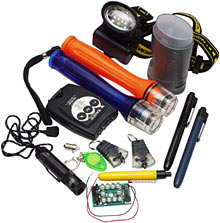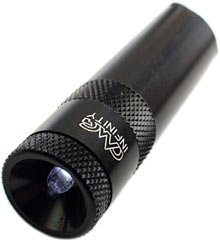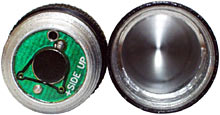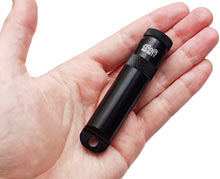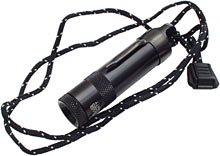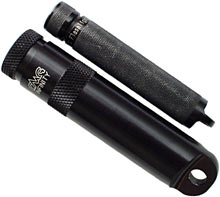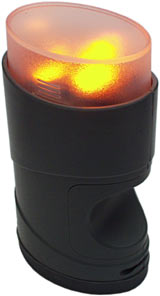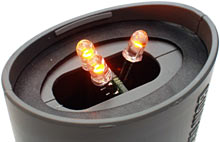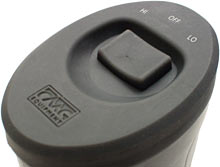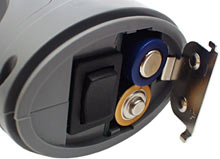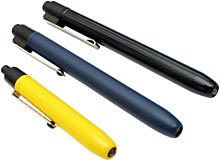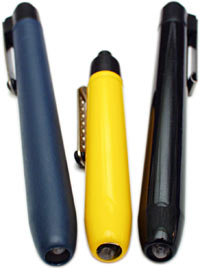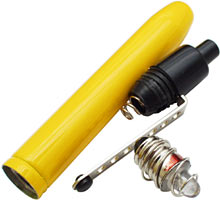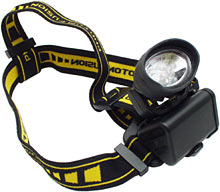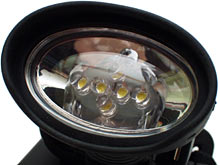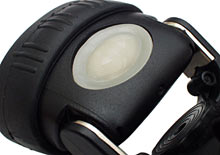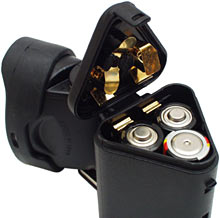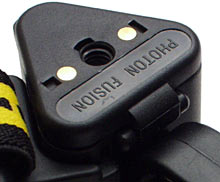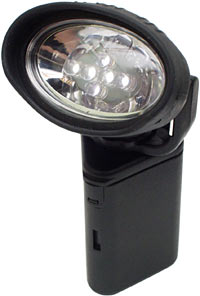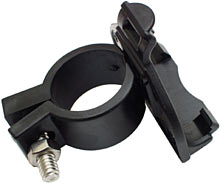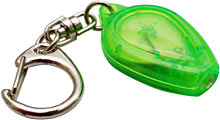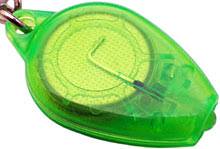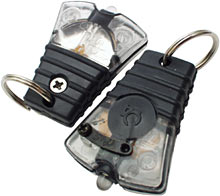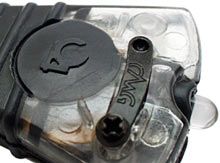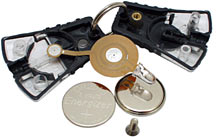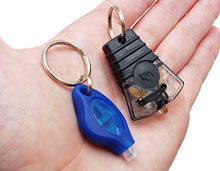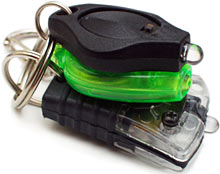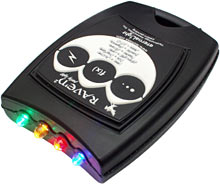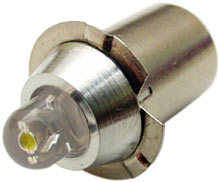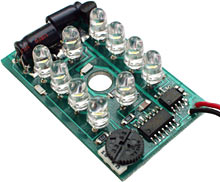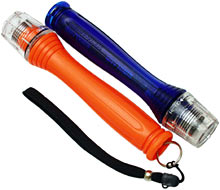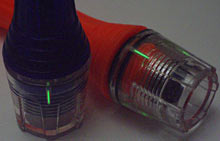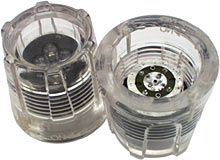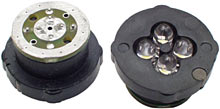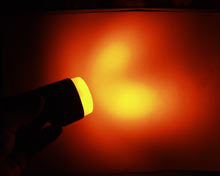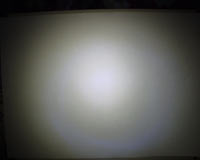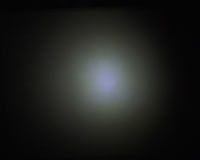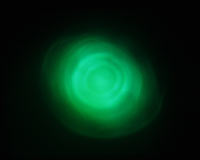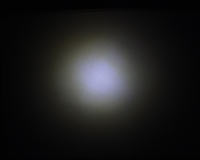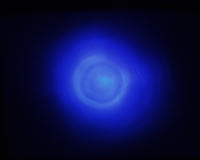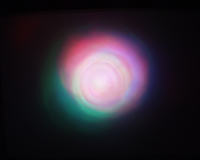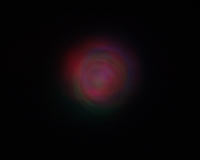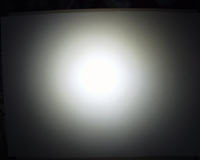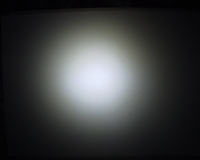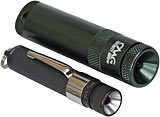
CMG, Sino Union, Photon, Gemlite, Technology Associates and Traser LED lights
Review date: 13 December 2001.Last modified 29-Sep-2012.
The place has, once again, silted up with LED flashlights. Another comparison beckons.
First, the descriptions and pretty pictures. Then, the power consumption figures and comparative light output shots.
CMG Infinity task light
This stubby little one-LED light from CMG is powered by a single AA cell, is built like a brick outhouse out of machined aluminium, and has a simple turn-the-end switch mechanism. There's a tiny step-up DC-to-DC converter built into the back of the lamp assembly that turns the less-than-1.5-volts from the single AA into the thick-end-of-four-volts that the LED needs.
Peering into the Infinity, there's not much to see; the lamp end unscrews to reveal a simple machined aluminium tube for the single battery. There's an O-ring seal that makes the light waterproof to 10 feet. If you want something that floats, though, this ain't it.
The Infinity's quite compact, but necessarily a bit chunky compared with Mag-Lite Solitaire-ish flashlights that use a single AAA cell. One AA alkaline gives you around twice the capacity of one AAA, though, and will tolerate high current delivery better as well. So, all things being equal, it's reasonable to expect two to three times as much battery life from a AA-powered light as a AAA-powered one.
The Infinity costs about $US19, and doesn't come with a battery (most LED lights do). But you do get a nifty lanyard with a glow-in-the-dark white spiral stripe, and a pocket clip too.
The Infinity closely resembles the Arc-AAA flashlight I reviewed in this piece. The Arc runs from a AAA cell, but if someone told you the same company made both lights, you'd believe them. The Arc's actually a newer product, though; the Infinity came first.
Apart from the power source, these two lights are as similar as they look. The Infinity's got no reflector behind its LED, but since LEDs don't emit much light to the side that doesn't make a lot of difference. The Arc-AAA has a rubber washer behind its lamp assembly that stops the battery from rattling around; the Infinity doesn't. That's about it for the physical differences, though.
The two little lights are similar in price, too; the Arc-AAA sells for $US24.95.
The Infinity will work from a non-rechargeable AA lithium cell. The Arc-AAA might work from a lithium too, but as far as I know, nobody's made a lithium AAA yet. You can get lithium batteries the size of a AAA cell, but they're 3.6 volt.
Lithiums are lighter than alkalines, have a bit more capacity, and have tremendous shelf life. It's a good idea to check to make sure a given flashlight will work properly from lithium AAs, though, because they deliver a nominal 1.7 volts per cell, which can burn out bulbs expecting the usual 1.5-unloaded-volt cells. A Mini Maglite, for instance, will burn really brightly from a couple of lithium AAs, but you'll go through two bulbs per set of batteries, if not more.
CMG say the Infinity will work fine from a lithium AA, though, and will also be a bit brighter.
Which is good, because this light needs all the help it can get.
The big difference between the Infinity and the Arc-AAA is in light output, and the Arc wins. The Infinity, with a fresh AA cell, had about the same output as the Arc-AAA with a seriously used battery that managed less than one volt, unloaded.
I'm still using my Arc with that battery, though; it's not at all a useless level of light output. It's considerably dimmer than it was with a fresh cell, but one of the great things about LEDs for illumination is that their output colour changes little, if at all, when you wind down their input voltage and thus their brightness.
Both LEDs and incandescent-globe flashlights get dimmer as their batteries flatten, but the light from an incandescent lamp also gets redder as it dims, and the human eye doesn't respond well to red light. The yellowish light from an ordinary incandescent globe is already biased towards the red end of the spectrum; light from white LEDs is much bluer, which makes it more visible for a given lamp efficiency and power consumption. As the batteries flatten, an incandescent globe gets worse and worse, and a white LED looks better and better in comparison.
What all this means is that even though the Infinity is one of the dimmest LED lights I've ever reviewed, that's not nearly as big a problem as you might think. People using keyring LED lights with clapped-out batteries, including me, routinely put up with much dimmer light than the Infinity offers. The human eye's a marvellous thing.
Fortunately, the low light output from the Infinity is matched by miserly power consumption, which I'll go into in more detail in the power-and-output section below. For its intended purpose - an always-with-you, huge-battery-life, close-work "task light" - the Infinity's great. Just don't expect to use it if you're heading out to spotlight wild pigs, or something.
Incidentally, according to this page, bargain hunters in the USA can also get first-generation or factory-second Infinitys cheap, at $US20 for two. For that money, this flashlight's definitely a bargain, even if you have to put up with a less-than-perfect-looking one.
CMG Bonfire tent light
If you think this is a pretty goofy looking flashlight, you're right. Fortunately, this isn't a flashlight - it's a "tent light", for use anywhere where you need a candle or two worth of wide-angle light. Like, for instance, seeing what you're doing inside a tent at night.
The Bonfire uses two AA cells to power three amber LEDs, which are mounted like this under the removable frosted plastic diffuser in the end of the light. The light can stand on its tail or hang from a provided lanyard, or you can hand-hold it and use it as a better-than-nothing flashlight. Remove the diffuser and bend the LEDs to all point in the same direction and it's an OK directional light, but that's really not what this thing's meant to do.
The Bonfire uses the same basic plasticwork as CMG's Phoenix lantern, which has a motion sensor but uses a conventional incandescent bulb. The casing's reasonably splashproof, but if you drop it in a pond you're going to have to shake the water out of it later. There's only a switch and a few resistors inside the light, so it's not likely to be killed by fresh water.
The switch end of the Bonfire has a rubber cap over it, which is there for weatherproofing; as long as the light's hanging with the cap upwards, rain can't get into it. The cap, however, makes it a bit awkward to push the two-position rocker switch that lets you select High or Low brightness mode. The difference between the two modes is obvious, but either is adequate for basic tent-lighting purposes. The quoted run time for High mode is 18 hours, and 30 hours for Low mode - but, as with other LED lights, you'll get usable light out of the thing for a lot longer than that.
The Bonfire battery bay lives under the rubber cap. The two AAs are retained with a metal door that feels cheesy when it's disengaged and free to flap around, but which works perfectly well when you clip it into place.
One design flaw in the Bonfire, which other reviewers have noticed, is that if it's dropped lens-end first from practically any height, the two spring contacts in the hard-to-get-at bottom of the battery bay get squished, and the two AA cells no longer make contact. I did a test drop from chest height onto low-pile carpet and that's just what happened, but it took me literally only seconds to bend the contacts back up using hemostats. If you don't have a similar handy needle-nosed high-grip plier-thing to hand - and particularly if you're stuck in the dark - you might find this task a lot harder. The Bonfire needs springier springs.
In high-brightness mode, the Bonfire's nothing like as bright as even a small gas lantern, or indeed a basic incandescent-torch-globe electric lantern. But you don't need a ton of brightness from a tent light, and bright electric camp-lamps need big heavy six volt lantern batteries to deliver decent run times. Better camp-lamps have a tiny secondary bulb for couple-of-candles mode, but if that brightness is all you need, why carry a big lamp?
The Bonfire's warm amber light gives a quite pleasing ambience, if you ask me, but it'll be a pain if you're trying to read maps, or do something else where accurate colour rendering is important, and you don't want orange lines on a white background to become invisible.
But for the purpose it's designed for, and considering the fact that it only costs $US25 or less, the Bonfire makes the grade. Tent, blackout, stuck-by-the-side-of-the-road-at-night; anywhere where you'd like some moderately bright diffuse light, this thing'll provide it.
Sino Union penlights
Sino Union Technology make a variety of cheap and cheerful LED light products, some of which I've looked at before. Their new Starlite-128PW (two cell) and Starlite-213PW (one cell) penlight models continue this trend.
Far and away the most expensive part of these lights has got to be the bulb. They really are pen-lights - their casings are just cheap aluminium pen tubes, wide enough to take AAA cells, with an LED-sized hole in the end. But the lamp they use is one of Sino Union's integrated-converter Starlite "bulbs", this time with a screw fitting instead of the PR-type flange fitting on the ones I checked out before.
There's no normal mounting point for the bulb in these penlights - it just sits in the end of the casing with a spring wrapped around it to give the negative terminal continuity to the case. The squished-spring mount also makes sure that the bulb doesn't point quite straight. Then again, no cheap penlight has a bulb that points quite straight.
The switch is a ballpoint pen style pushbutton on the end of the casing. I got two 128PWs and one 213PW for review; of those three, two switches felt OK, but the switch on one of the 128PWs lights didn't switch consistently, and felt as if it was about to break.
These, though, are not top-dollar items. Sino Union's more normal looking flashlights have quite OK quality bodies and are very cheap indeed; the penlights can't be any more expensive.
And they do work; the bulbs are good, and the switches on the two that behaved themselves seem fine. I particularly like the little single-cell model.
Worst case scenario, you'd buy one of these and the switch'd drop dead, or the spring would do something nasty, or something. Which would leave you with a perfectly good bulb that you could screw into a cheapo penlight from the supermarket that used the same number of cells and the same lamp fitting. If you get a PW-series light with an OK switch, the thing'll do. And I like the little one-cell one.
Photon Fusion
LRI, makers of the Photon Micro-Light range, got into the microcontroller-equipped light market with the Photon 3. Now, they've scaled the idea up.
The Photon Fusion is a multi-purpose, multi-mode illumination widget that can be used as a headlight, a bike light or a hand-held flashlight. Or as an impromptu disco light. Or as a distress light. To name but a few of its features.
The Fusion lamp assembly packs six LEDs (white in the one I got for review; there are also blue, red and infra-red models), which give it a pretty respectable maximum light output without putting too terrible a load on the three AA cells that power it. The lamp assembly can tilt 180 degrees, which is more than enough to get light wherever you want it when you're using it as a headlamp, or to illuminate the right bit of road in front of your bike.
On the top of the lamp there's this rubberised button, which glows in the dark, and which also catches some of the side light from the lamp. As with the Photon 3, you can press one side of the button to get maximum power "Hyper-Bright" mode whenever you need it. Hyper-Bright mode latches on, though; there is no intermittent mode. LRI say Hyper-Bright will drain the batteries in about six hours.
The other half of the Fusion's button activates its fancier modes. Again, as with the Photon 3, you cycle through those modes by holding the button down, and turn whatever mode you've cycled to on and off by pressing the button momentarily.
There are high, medium and low brightness modes; the high brightness one is suitable for general outdoor looking around, but ought to flatten the batteries about half as quickly as Hyper-Bright. Medium mode is, well, medium; low brightness mode is suitable for reading and other close-up jobs. There's also a disco-light fast strobe mode, a bike-tail-lamp medium strobe, and a ...---... SOS strobe mode for attracting people as quickly as possible to the place where you're busy dying.
Well, there's meant to be an SOS strobe; my pre-release Fusion just had another, even slower plain flash mode in place of it.
The Photon's last special mode runs the light up to high brightness, then turns it off after about a minute - but it ramps back down to turn-off mode, and the time it takes to do that tells you how much juice the batteries seem to have left. Five second ramp-down - lots of power. One second ramp-down - batteries nearly flat.
The three (included) AA cells are firmly held in the triangular-prism battery bay, whose lid is held in place with a very solid clip. You can open it without a levering tool, but I'd be very surprised if it ever opened by accident. If it did pop open and water got in, or the batteries leaked, the contacts would probably just need a light wipe; they're gold plated.
The battery box connects to the lamp physically with a keyed screw fitting (you can only attach the lamp one way around), and electrically with brass contact buttons that mate with little gold plated spring-loaded tabs on the lamp. There's one attachment point on the side of the battery box, and one on the end.
So to put the Fusion in flashlight configuration, you unclip the lamp from its headband mount (which is another rather solid fitting which is not going to come loose accidentally unless you whack the light very hard indeed), unscrew the lamp from one spot, and move it to the other. This configuration also makes it easier to use the Fusion as a table lamp; it tends to tip over in the lamp-on-the-side arrangement.
If you want to use a Fusion or two on your bicycle (red one on the back, white one on the front...), this'll let you do it. It's an optional clamp that has a normal bike-frame ring on one side and a clip the same as the one on the headband on the other. Transferring the Fusion from one clip to the other only takes a few seconds. If you're engaged in a competitive sport that involves both mountain-biking and spelunking, this may make this product a must-buy for you all by itself.
As a flashlight, the Fusion's perfectly useable, but feels a bit weird. It's short and triangular, after all. As a table-lamp, it's fine, and the angled head makes it easy to use it for reading without having to light the whole area with maximum power mode. As a headlamp, it's quite comfortable, and the switch is easy to use.
The Fusion costs a hefty $US81.95 direct from LRI, which is on the steep side if you just want a flashlight. An EternaLight Model 3 Ergo, as reviewed here, isn't tremendously dimmer than the Fusion, also has a bunch of fancy microcontroller-driven dim and flash modes, and costs about half as much. The EternaLight's got good waterproofing, too; the Fusion's just "water resistant". It'll work OK in the rain, but you wouldn't want to drop it in the ocean.
But if you want a light you can clip onto your bike or strap onto your head without having to use any duct tape or get any blisters, the Fusion makes the grade - and it's an OK hand-light too. Most flashlights aren't much use as a table lamp; this one is. LRI have spare parts for the Fusion, too; if you scratch the lamp lens or break a hinge, you can replace them. And you could even attach two heads at once to the one battery box, if you were feeling silly.
If all you want is an LED headlamp, then I reckon FrontaLED's models (like the Trekker, reviewed here) are better than the Fusion. But you'd want them to be, since they cost 232 Swiss Francs (about $US140, as I write this), and all they've got is two brightness modes.
If you've got a use for a reasonable number of the Fusion's profusion of features, it's a good buy.
Emerald Gemlite
The Gemlite, made for no immediately obvious reason by programmable logic controller outfit International Parallel Machines, is considerably simpler and cheaper than their other products. It's a couple of CR2016 lithium cells, in a translucent plastic case, with a high intensity LED so mounted as to turn on when you squeeze the thing.
The two lithium cells are rated at three volts each, and six volts is far too much juice for the various coloured LEDs in the Gemlite range (there's a red one in there too - it probably runs from a single CR2032 cell). But any high intensity LED is truly massive load from the point of view of a coin cell, and the battery voltage thus under load to something perfectly appropriate for an LED flashlight.
The up side of this design philosophy is that it gives you a really teeny-tiny light; the down side is that the full-brightness battery life is maybe a minute, at best.
Thanks to the one-colour-only light output of LEDs, though, key-ring lights like the Gemlite can deliver many hours of worthwhile light output, without sliding down the spectrum into uselessness like an incandescent light source. They're a very great deal dimmer after a couple of hours than they are from fresh batteries, but they start out quite alarmingly bright, and are good enough for keyhole illumination purposes even after half a day of constant on-time.
There's no way around the quick-dim problem for tiny flashlights, unless someone comes up with a battery technology that can be made as small as a coin cell and can deliver tens of milliamps, against the roughly 0.1 milliamp that these cells expect to supply. You could put a DC-to-DC converter in the light to keep the LED voltage up over the whole battery discharge curve, but that'd increase the current they had to supply even more (because there ain't no such thing as a free lunch...), which would kill the poor little lithiums much faster. But the things are quite OK as they stand, and lots of people love them.
Most of the world's LED keyring lights aren't Gemlites, though; the single most popular brand is the Photon Micro-Light. The Gemlite's obviously just another Photon knock-off, but it's a perfectly good one - and it's cheap.
You can buy Gemlites direct from the manufacturer for $US7.99 each, plus a couple more bucks for shipping of US orders (which can apparently include several Gemlites). The blue, green, red, yellow and white Gemlites all cost the same, and all come with batteries pre-installed, just like the Photons.
For comparison, the basic Photon I "squeeze light", which is functionally equivalent to the Gemlite, costs $US11.95 each from the manufacturer, including shipping. Hosfelt sell Photon Is for only $US8.95, but that doesn't include shipping.
Like the old model Photons, the Gemlite case is held together by friction-fit pins; to open it and replace the batteries, you lever the case halves apart with a small screwdriver. It's a bit fiddly, but not horribly so.
Overall, for the money, I like the Gemlite. The keyring hanging off it is a nice little spring-clip unit, it looks cool, its switch design seems fine, and you can't complain about the price. The Gemlites don't have the Photon's super-tough case, gold plated contacts or lifetime manufacturing-defect guarantee, but they're about half the price.
I've seen various knock-off keyring lights that are rubbish - lousy switches, dim LEDs, cases that fall apart. The Gemlite is not one of them.
CMG O4 mini task light
Without further ado, another keyring light.
CMG's entry in this market segment is considerably bigger than most - but it's still not big.
The O4 is, essentially, just another two-coin-cell one-LED light, but it's been beefed up into a quite serious piece of camping kit, and should be able to survive considerable abuse. At $US16 or so, the O4 lights cost about the same as a Photon Micro-Light II, and they've got the same feature set, too - you can squeeze for momentary light, or lock the switch on.
The Photon II lock-on mechanism is a tiny slide switch; the O4 mechanism is simpler, and beefier. There's a steel swing-arm screwed to the top of the light; swing it down onto the switch and it presses it constantly. The arm's not what you'd call huge, but it's a lot bigger than the tiny Photon gizmo, so it ought to be a lot easier to operate if you're wearing gloves.
To take the 04 apart (which isn't something you'll have to do until the included batteries run flat...), you only have to remove one Philips head screw (which is not a minuscule Photon-II-type one) and then separate the two halves, which have a rubber gasket in between. This light's got proper waterproofing; a dive light it isn't, but it fears no puddle.
The front of the O4's held together by a couple of mating plastic pegs and sockets, which were really tight in the lights I got for review and required considerable unnerving screwdriver-levering of the case to separate them. I was worried that this might damage the gasket, but as it turned out, it was fine. Once you've got your O4 apart once, though, a dab of silicone oil on the pegs to make it easier to do the next time might be in order.
Photon lights are tough, but the O4's chunky case definitely puts it in the running. The Photons are made of glass fibre filled polyurethane, which is much tougher than non-composite plastics; the O4's made of polycarbonate, with substantial reinforcing ridges inside and rubber armour on the back half. I haven't got enough spare lights to put them to sledgehammer-and-angle-grinder tests, but I'd be surprised if the O4 died easily.
Not many tiny-lights are likely, of course, to have rocks dropped on them, or get crunched between two links of a chain, or get stuck under Grandma's chair rocker. But if you're anticipating being very impolite indeed to your keyring light, an O4 ought to be able to take it.
Here's the O4 next to a Photon Rav'n Party Light (as reviewed here), which is the same size as the other small Photon lights...
...and here's an O4 with the Gemlite on top of it, and a Photon II on top of that.
The O4's not terribly expensive, comes with a variety of beam colours, and has the same basic performance as other key-ring lights, in a more macho form factor. It's not a revolution in illumination technology, but it's worth checking out.
Technology Associates EternaLight Rave'n 2
If Disco Stu has a flashlight... well, to be honest, it's probably some sort of portable lava lamp.
But if Stu were a bit more up-to-date and had a flashlight, it'd be an EternaLight Rave'n2.
That is quite enough funkalicious typography for one day, if you ask me. From now on I'm calling this product the Raven 2.
The original Raven was the first LED flashlight I ever reviewed, here. Both Ravens take full advantage of the microcontroller-driven EternaLight design, which allows the "plain" EternaLights to dim and strobe and flash and so on. The Ravens, however, have one red, one green, one amber and one blue LED, which together add up to a surprisingly useable flashlight beam, but which can also strobe and chase and pulse in various entertaining ways.
This light, by the way, is not to be confused with the extremely similarly named Rav'n Party Light from the Photon Micro-Light range, which I review in this comparison. The little Party Light has multi-colour output, too, but it's a keyring-sized light and close to useless as an actual flashlight, because it uses a single, relatively dim tri-colour LED. The Raven lights have four separate LEDs, and work perfectly well as an ordinary see-where-you're-going sort of light, as well as for ooh-pretty-colours purposes.
Technology Associates' spiel for the new-model Raven says that it "adds durability and some refined features", and that's pretty much right.
Basically, it's a hybrid of the old Raven and the new "Ergo" model lights; it's got the sleek curvy hand-phaser case of the new-style EternaLights, and their new modes, as well as the original Raven ones.
Turn the Raven 2 on with the rightmost of its three buttons, and it's in Timer mode, where all four lamps turn on for two and a half minutes, then one goes out every two and a half minutes until the light's off again. This is mainly to stop the batteries going flat if you turn the Raven 2 on by accident. Which, incidentally, you can do by simply putting the thing next to a GSM mobile phone that decides to go to full broadcast power for a moment. All of the EternaLights I've seen have this quirk.
One press on the central Mode button takes you to On/Dim mode, where the Raven 2 will stay on until its batteries go flat, and where you can use the leftmost Adjust button to dim the light, in eight steps. The dimmer is one of the most useful EternaLight functions; it lets you coddle your batteries when you don't need full output, which is often.
The next mode is Dice, in which the lights rapidly cycle and the Adjust button makes them slow down and eventually settle on one fairly randomly chosen colour. Then there's Drag Race, in which Adjust gives you three red flashes, then amber, then green. Next, StopLight lets you cycle through the four colours with the Adjust button (the original Raven only cycled through green, amber and red, not blue).
Then there's Cops, which flashes the red and blue lights police-light-bar style, with the Adjust buttons changing the rate. Flasher mode flashes all four lights with Adjust changing the rate; Strobe mode flashes all four lights at a faster, but still adjustable rate; Blaster mode cycles through the four lights very dimly then turns them all on at full brightness when you press Adjust; Sequence flashes each light in turn at an adjustable rate; Chase flashes all lights but one in turn at an adjustable rate; and finally UFO gradually brightens and dims the four lamps in a manner probably quite acceptable to Klaatu.
The Timer and enhanced Stoplight modes are nice (the only way to turn on just the blue LED of the basic Raven is by using Dice mode and hoping that it lands on blue...), but it's the physical design that makes the biggest difference. My old Raven has been used quite a bit and dropped several times, and now has some battery and switch issues which may or may not be fixable. The new-style EternaLights are bigger than the old ones, but they're much tougher, too; the three AA batteries are better packed (you still need a Philips screwdriver to change them), the circuit board's held down better, and the thing's waterproof, too. Install lithium AAs instead of the included alkalines and an Ergo EternaLight will float.
The Raven 2 is, essentially, the Raven perfected. It's still both practical and fun, and at only $US39.99 from Technology Associates, it's not terrifyingly expensive, either. A superb gift for the Geek Who Has Almost Everything.
Technology Associates VersaLux PR-2
The VersaLux PR-2 is not a flashlight; it's just a lamp. It is so named because it gives you a white LED plus a step-up DC-to-DC converter that lets the LED run from two 1.5 volt cells, all stuffed into a PR-2 type flange torch-globe package.
The LED's been profiled to remove its own lens effect and make it radiate light in the same way as a normal PR-2 globe, so you can just drop it into any two-cell flashlight that takes this kind of globe and go. It'll be considerably dimmer than a normal incandescent globe from the supermarket, but it'll also be a lot kinder to the batteries, and give you that magic LED beam colour stability that lets you use your batteries all the way to the end without horrible brightness loss. Technology Associates are selling the PR-2 for $US12.99.
This is a perfectly good product, but it's not one that I'm going to spend a lot of time talking about, because I've reviewed it before. Either the PR-2 is a rebadged Sino Union NPLB128R (as mentioned in my review here), or I am a gentleman of Dutch extraction.
The NPLB128R is a good little bulb. So's the PR-2. Funny, that.
Technology Associates VersaLux Utility Light Module
The Utility Light Module isn't a ready-to-go light. It is, instead, a rather flexible little multi-purpose illumination unit, which offers various different light levels from various different input voltages. And it's only 50 by 30 by 14.7 (1.95 by 1.18 by 0.58 inches) in size, so it can fit into all sorts of places - little clear-lidded project boxes, flashlight and headlight housings, and so on.
You can mount the ULM in a box or other casing with the sticky substance of your choice, or use a quite big bolt, if you like - there's a quarter-inch hole in the middle of the module's circuit board.
The ten LEDs on the ULM make it about as bright as all but the most outrageous multi-LED flashlights, if you want it to be. But it's also got an adjustment dial that lets you turn the lights down, all the way to nothing if you like.
The ULM will run, at pretty much full brightness, from any power supply from 2.2 to 13.8 volts. In my testing I found that its full-power light output actually fell noticeably below about 7.5 volts, but the difference isn't huge, and the module was still working fine at lower output from a hair over two volts.
Thanks to the ULM's regulation circuitry and, once again, the constant colour of LEDs, you can get some pretty impressive full-power light life figures out of this thing. Technology Associates quote more than four hours from a 9 volt alkaline battery, and more than 110 hours from four D cells in series.
For $US49.99 from Technology Associates (The LED Light stock them as well, for $US48), this module's considerably more expensive than a simple lump of strip board with LEDs and a limiting resistor or three on it - but it does a lot more, and you don't have to do your own soldering.
If you want a connect-and-go general purpose LED light module which can handle all sorts of supply voltages, and doesn't care if its supply wanders from three to 13 volts from second to second, here one is. The ULM performs as advertised.
There are several ULM projects on the Technology Associates site, here.
Traser Teknolite
The Traser Teknolite, from H3 UK, is a rather stylish four-white-LED flashlight that runs from three (included) AA cells.
The Teknolite costs £29.99 (UK pounds) directly from Traser, which is about $US43 as I write this. For your money you get your flashlight (in one of a variety of solid or translucent colours - I got a solid orange and a translucent blue one to play with), your batteries, a nice tough lanyard to loop through the ring on the back of the light, and...
...these. This long-exposure shot taken in a dimly lit room shows off the little Traser sticks permanently encased in the ends of the Teknolites; each light has two of them, and their light refracts around the end of the light so they're visible from all angles.
The Trasers are tiny glass tubes with a phosphor coating and a tritium gas fill, which keeps them glowing gently all day, every day, for well over a decade.
Tritium is hydrogen-3 - instead of the single proton in the nucleus of a normal hydrogen-1 atom, it's got a proton and two neutrons. It's an unstable, radioactive isotope, but it's not very radioactive - just enough to keep thumping electrons into the phosphor coating on the Traser sticks. The same technology's used on various other luminous items that don't need to be "charged up" in light; old-fashioned radioluminescent formulations had more potent substances in them, which was bad news for the Radium Girls.
If you don't eat or inhale tritium, though, it's harmless; beta radiation (high energy electrons) can be dangerous if it's powerful, but beta radiation from tritium isn't.
So the glowy things in these lights aren't going to turn you into a superhero and/or cause you to sprout giant tumours. But they do make the lights quite visible in the dark, thus fixing the hole-in-my-bucket problem of not being able to find your flashlight because it's, ahem, dark.
Apart from the Trasers, there's nothing totally amazing about the Teknolites, but they're an excellent example of the straightforward three cell white-LED flashlight breed. Their curved bodies are very comfortable to hold, their four LEDs give them a respectable light output, and they use the standard, simple, twist-the-end switching mechanism, which along with a couple of O-rings gives them a ten metre water resistance specification. These aren't proper dive lights like the Tektite lights I review here, but they're more waterproof than most people need.
The Teknolite lamps are press-fit in the clear end of the flashlight, and are easy enough to remove with needle-nosed pliers.
The lamp assemblies have a simple concentric-tracks layout, and include a little grey hydrogen catalyst pellet. If something goes wrong with the three AA cells - if salt water gets into the light, or if the cells are just left there long enough to leak - hydrogen can build up and, in a sealed flashlight like this, conceivably cause the casing to explode. The catalyst soaks up hydrogen, and stops that from happening. If you do have a flooded-light or leaking-batteries mishap, you should replace the pellet.
The only things I don't like about the Teknolites are pretty trivial.
First, there's no shield around the lamp assembly. There has to be a clear lamp housing for the Trasers to be visible from every angle - otherwise there'd have to be rather more than two of the tiny glow-sticks - but that clear housing catches a significant amount of light from the lamp assembly and spits it out sideways, where you probably don't want it. A diffuse beam is a good thing when you want to see where you're walking, and the Teknolites deliver that as well as any other plain-LED light. But light that escapes directly to the side doesn't do much but shine in the user's face.
The copper strip that runs from the back of the Teknolite battery compartment to the lamp is also a tiny annoyance, because although it's captive in a channel moulded into the inside of the casing, it can rattle about a bit. In a cheap flashlight, such noises would be par for the course, but in something as expensive as a Teknolite, it's worth mentioning.
If the rattle irritates you, you can cure it with a couple of blobs of Blu-Tack or a little paper shim. I told you my complaints were pretty trivial.
If you don't need dimmer modes or other fancy features, but just want a good solid reliable flashlight with useful brightness, the Teknolites fit the bill. They're not bargain priced, but you can definitely feel what you're paying for, and the Trasers are nifty.
Power consumption and output
CMG Infinity
Remember how I said the Infinity was dim?
Well, this is the best it could manage in my standard beam-power test, looking at a sheet of A3 paper hanging long-side-horizontal 40cm away from my ISO 100 F2.8 digital camera, with a 1/20th second exposure. The flashlight's right next to the camera lens, pointing at the paper.
Just because the camera can hardly see it at this exposure setting, though, doesn't mean a human can't. As I said, this thing's very far from uselessly dim.
Here it is at 1/5th second, which makes it look more respectable. The Infinity output is a lot bluer than the white-LED average; I set my camera's white balance from a big white-LED flashlight, and the Infinity's light is considerably further up the spectrum.
This isn't a bad thing, though, unless super-accurate colour rendering matters to you.
The flipside of unexciting brightness is modest power consumption; the most I could measure the Infinity drawing from its AA cell, using my lowest-resistance ammeter, was 40 milliamps (mA). Take the ammeter out of the circuit and the current will rise a bit, but not a lot; 50mA from a fresh cell, say.
This adds up to a quite comfortable two straight days of close-to-full-brightness output, with ages more dim but not useless light after that.
This power consumption figure also means the Infinity's LED is probably running at little more than 20mA, which'll give it an awesome life span - quite possibly the full canonical hundred thousand hours until it's noticeably degraded, and plenty more than that before it's useless. If you don't lose or somehow manage to destroy this flashlight, it'll still be good when AA batteries are well out of fashion.
If you're anticipating a catastrophe that destroys civilisation in the near future, this is the flashlight you want. It's not amazingly bright, but its battery life is superb, it uses probably the commonest battery size in the world, and you couldn't kill it with a big stick.
Personally, I prefer the Arc-AAA; it's much less of a bulge in my pocket, its battery life is more than acceptable, and it's substantially brighter than the Infinity. But the Infinity's still got a lot going for it.
CMG Bonfire
The Bonfire's diffuse output makes it hard to get a shot of its light pattern, but this gives you some idea. You can bend the LEDs to make the light pool wider or narrower, if you like.
Here's the brighter lobe of the Bonfire's output, at 40cm from the paper, in High mode, with a generous 1/5th second exposure.
In High mode, the Bonfire sucks around a third of an amp out of the two AA cells that power it, which is quite a lot by LED light standards. As the cells age that current will fall rapidly, and there'll be noticeable brightness loss as well. CMG's 18 hour quoted run time is realistic only if you don't mind losing a lot of brightness over that period. You probably won't, mind you, but it's worth knowing nonetheless.
In the almost-as-good Low mode, the Bonfire draws maybe 140mA, which is much kinder to the AAs. The 30 hour quoted run time in this mode, though, is again allowing for a lot of brightness loss.
Photon Fusion
Here's the Fusion's Hyper-Bright output, at 1/20th second. It's a bit too bright for the camera in this mode...
...but dropping to 1/40th second removes the whited-out centre.
This is the Fusion's minimum power output, this time at 1/5th second. It's much dimmer than even the CMG Infinity now, but it's still more than bright enough to read by, in headlamp mode. Actually, once my eyes were accustomed to the dark, I found minimum brightness mode to be perfectly acceptable for walking around the house and garden; you can see further than where you're putting your feet.
In Hyper-Bright mode, the Fusion draws around 300mA, which is not something that its three AA cells enjoy delivering, but is no more than the Bonfire asks from its two cells. In its normal full-brightness mode, the draw falls below 200mA; medium power is a mere 50mA or so, and low power is a super-miserly 20-odd milliamps. You could trudge around a cave system for five or six straight days with the Fusion in Low mode and not lose too much brightness.
The Fusion's flash modes all draw around 100mA.
Sino Union penlights
The one-cell Sino Union penlight does well, for a cheapie-light. It's a lot brighter than the Infinity, as this 1/20th second exposure shows.
The two-cell penlight is the same, only more so. Very pleasing, for an inexpensive skinny light. Shame about the switch.
The one cell penlight draws a rather chunky more than 280-odd milliamps from its AAA cell, which is rather rude to the poor little thing, but par for the course for step-up single-cell lights with decent brightness. The two cell light draws maybe 150mA, which should give it more than twice the battery life. AAAs start to run out of puff at anything above about 20mA.
Gemlite
Green LEDs have an output colour that pretty much perfectly matches the human eye's maximum sensitivity, and the Gemlite I got was green. So it, unsurprisingly, looked really really bright.
Another 1/20th second exposure.
People tend to be seriously startled by the brightness of keyring lights with fresh batteries, but as mentioned above, you'd better not get used to it. Most of the time, these lights will be running from clapped-out cells that don't give them even a tenth of this brightness. I didn't bother measuring the Gemlite's current draw; I could hear the coin cells screaming before I even opened the case.
But full brightness is certainly nice while it lasts.
The Gemlite may be cheap, but this green one at least is up there with every other current quality green-LED key-light.
CMG O4
I didn't measure the O4s' current draw, either; I believe in letting CR2016s die in peace. The brightness of the two O4s I got, though, was right up to new-tiny-light standards.
Here's the output from the white one, at 1/20th second. It beats both Sino Union penlights hands down. It won't for long, though.
Here's the blue one's output. The white LED in the other one is really blue, as well; it's just got a phosphor coating on it that turns some of the blue into other frequencies, which add up to white. Without the phosphor, blue LEDs driven by a decent voltage are amazingly bright.
Raven 2
Yup, that's Raven output (at 1/20th second). Four puddles of different-coloured light, which combine to give quite acceptable colour rendering in the middle of the beam. Anything close to the light will cast weird fringey shadows, though.
Since none of these LEDs have phosphor to shine through either, the total light intensity from the Raven 2 compares very favourably with what you get from four-white-LED lights. The red and amber lights don't contribute much compared with the blue and green, but those two can pretty much carry the show by themselves, as far as intensity goes.
The Raven's minimum power output (the eighth dim level), at 1/20th, looks underwhelming - but, once again, is surprisingly useful in the real world, especially if your eyes are used to the dark. Minimum power is plenty for lighting your way to the bathroom in the middle of the night.
At maximum power, the Raven draws maybe 250mA from its three AAs; at minimum power, maybe 20mA. So this is another light that'll last all week at minimum brightness.
VersaLux Utility Light Module
The ULM's brightness is continuously adjustable from full to nothing, so I only tested it at full brightness.
Here it is, running from a mere six volts, with a 1/20th second exposure. Too bright for the camera...
...so here's 1/40th.
It's only drawing 150mA in this mode, for an output power of 0.9 watts.
Fiddling with the input voltage revealed that the ULM peaks, at 13.8 volts, at about 1.24 watts - but that's only a 90mA current draw. At three volts and below, it hangs around 0.81 watts, which means a current draw of almost 300mA for the lower voltages.
The ULM didn't turn a hair as I twiddled the voltage dial; a plain LED array powered through a simple current limiting resistor will drop dead very fast indeed if overdriven significantly, and will fade to nothing quite quickly at voltages well below its rating. The ULM really is in a class of its own, here, and has comparable illumination power to a flashlight globe with around a two watt rating, thanks to its very white output.
This thing's the kind of product that people don't know they need until they see it.
Traser Teknolite
At 1/20th second, the Teknolite's output is about as bright as the camera can handle. This is good solid performance for a three-cell, four-LED flashlight, and more than bright enough for all sorts of tasks.
From three fresh cells, the Teknolite draws a bit more than 200mA, which is a good draw level for reasonable battery life.
As far as simple light output goes, the Teknolite's really one among many. But its other features make it rather interesting.
CMG addressed the Infinity's brightness problem. Check out the Infinity Ultra.
CMG's page for the Infinity task light
CMG's page for the Bonfire tent light
LRI's page for the Photon Fusion
Sino Union's site
(Sino Union products are available in the USA from Sinotone International Limited in San Francisco.
Phone (650) 583-8306, fax (650) 583-8326, e-mail sinotone@yahoo.com.)
CMG's page for the O4 mini task light
Technology Associates' page for the Raven 2
Technology Associates' page for the VersaLux PR-2
Technology Associates' page for the VersaLux Utility Light Module
Traser, the makers of the Teknolite, are now known as H3 UK.
